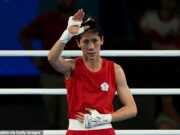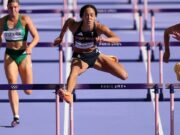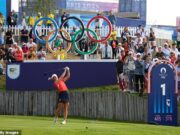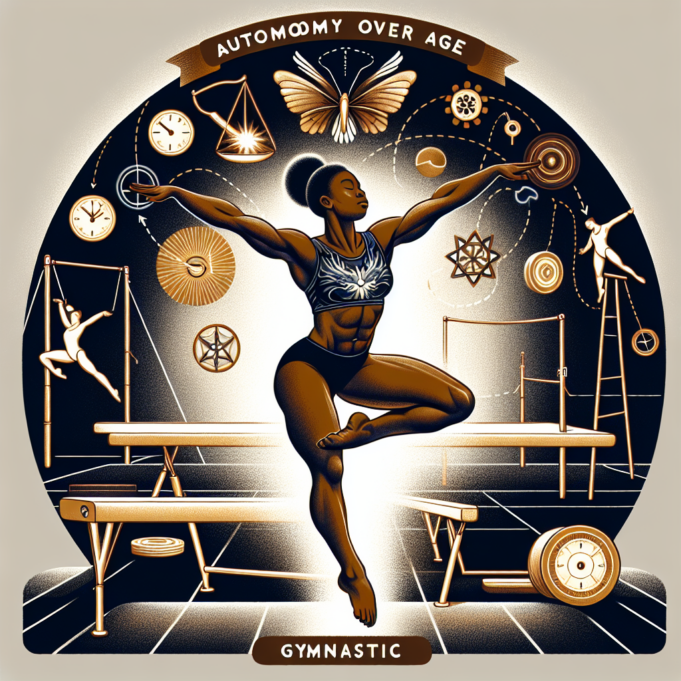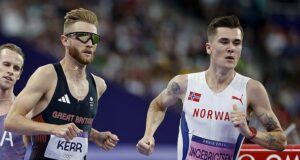Towards the conclusion of a jubilant press conference celebrating the United States’s victory in the gymnastics team final on Tuesday night, an unexpected figure took the microphone to pose a question to the winning team. The surprise questioner was none other than Aly Raisman, a three-time Olympic gold medalist and one of the most illustrious US gymnasts in history.
The Rio 2016 Olympics marked the second and final appearance for Raisman, coinciding with the rise of Simone Biles. As the oldest member of the team, Raisman’s experience and maturity earned her the endearing nickname “grandma” from Biles and her fellow teammates. Their success in the team competition made Raisman the oldest US gymnast to win an Olympic gold, achieving this milestone at the age of 22.
After holding that record for eight years, Raisman was on Tuesday moved down from first to fourth on the list. The current US team boasts three women over the age of 22: 27-year-old Biles, 24-year-old Jade Carey, and 23-year-old Jordan Chiles. With Sunisa Lee also at 21, four of the five members of the formidable US team are over 20.
Over recent Olympic cycles, women’s artistic gymnastics has transformed in remarkable ways. Following the rise of teenage prodigies such as Olga Korbut and Nadia Comaneci in the 1970s, it was commonly believed that female gymnasts peaked during their teenage years, making it unlikely to maintain complex routines as they matured. However, the average age of top gymnasts has risen, with several prominent athletes enjoying lengthy careers. This trend has only been amplified in Paris, where older gymnasts have made a significant impact, including the enduring excellence of Biles, who became the oldest gymnastics all-around champion since 1952 on Thursday.
Nadia Comaneci was 14 years old during her perfect 10.0 performance at the 1976 Olympic Games.
Photograph: Suzanne Vlamis/AP
While many of Biles’s incredible skills are one-of-a-kind, the way she has conducted herself throughout her career and achieved such longevity will undoubtedly be a key aspect of her legacy. As she transitioned into a senior gymnast and participated in the famed monthly ‘camps’ at Marta Karolyi’s ranch, the former US team coordinator, Biles and her coach, Aimee Boorman, recognized that they would have to forge their own path. “They used to try to put us in a box and they were like, ‘If you weren’t like this you’re not going to be successful,’” Biles reflected. “Whenever I came around, it wasn’t really my style. At the ranch [with] Marta, nobody really would talk and laugh and all that stuff. But I was like, ‘Yeah, that’s not how I do gymnastics.’
after newsletter promotion
“So I’m going to continue to do it how I know and how I love because this is the reason why I fell in love with the sport. Once that started changing, and Marta started understanding that, then the girls started showing a little bit more of their personalities. Over the years, we’ve gotten to do that and now it just goes into our longevity as well.”
Throughout her career, Biles has demonstrated that a gymnast can find joy in their work, maintain a fulfilling life outside of the gym, and still perform at full strength to become the best athlete they can be. Many talented gymnasts have faced overtraining and injuries as coaches pushed them to excel at a young age. Through her own extraordinary journey, Biles has illustrated that it is possible to evolve consistently over a gymnastics career, gradually acquiring new skills. Her longevity has also afforded her the chance to overcome significant challenges and return even stronger.
As a powerful and resilient athlete, Biles has helped reshape the perception of gymnasts’ body types that can thrive in the sport and dismantle outdated myths: “It was always said that the smaller and lighter you are, especially in women’s gymnastics, the easier it is,” noted 2014 Commonwealth Games champion Becky Downie. “As a child, you have a more petite, robust body. But then there was that shift. Not only within our sport and its funding but with the rise of American athletes. They were strong, muscular; not the tiny-bodied athletes of the past. This really changed the narrative, showing that one can indeed be muscular and strong, and that it’s actually advantageous.”
Rebeca Andrade’s silver in the women’s all-round final is her fourth Olympic medal. Photograph: Andrzej Iwańczuk/NurPhoto/Shutterstock
Biles isn’t the only older gymnast thriving in Paris. The entire women’s all-around podium on Thursday highlighted this remarkable shift. At 25, Rebeca Andrade has overcome three torn anterior cruciate ligaments (ACL) and is only now in her 20s realizing her immense potential, emerging as one of the greatest gymnasts next to Biles. Lee, who made a remarkable return after becoming the 2020 all-around champion, secured a stellar bronze medal, all while remaining in remission from kidney disease. “It’s empowering to know that younger athletes can influence the skills they want to perform and dictate their nutrition, training, and strength conditioning,” Downie expressed. “They are involved in everything, transforming the relationship into a cooperative athlete-coach partnership rather than a dictatorship. This shift is why we are witnessing better outcomes and ultimately happier and healthier athletes.”
Now at 32, Downie is set to compete in the uneven bars final after achieving the third-highest score on that apparatus during the team final. The 28-year-old Elsabeth Black concluded the all-around final as the sixth-best gymnast globally, while 33-year-old Jade Barbosa won bronze for Brazil.
The era of the “grandma” gymnast as an outlier has vanished, as these athletes have shown future generations that with the proper care and dedication to their careers, there are virtually no boundaries on how long a gymnast can excel at the highest level.








